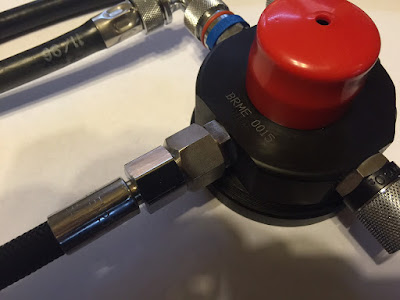Welcome to my old school Drager Dolphin Project. The idea of this project actually began a
while back when I was teaching a CCR course, and explaining differences between
the modern-day electronic CCR’s and the early recreational SCR’s. The
conversation turned to the Drager Dolphin, its simplicity, and how it
functioned as an entirely mechanical rebreather. I later found myself reminiscing about my time
on the Dolphin, and how far rebreathers had advanced in such a short period of
time. I thought how nice it would be to have a functioning Dolphin to use as a teaching tool, and also as an easy way to introduce divers to rebreathers. I've found that a lot of open circuit divers are interested in rebreathers, but many are not ready to make a $10k investment in a CCR. Many just want to try a rebreather, and what a better way to introduce them with a Dolphin. The benefit to me would lower operating and maintenance costs compared to using my CCR's for discover sessions. Only one problem, Drager stopped making the Dolphin (and parts for it) many years ago. The Atlantis/Dolphin is still listed on
the PADI continuing education flow charts, so I figured there must be people around still diving it. But what I learned was that although it is still very popular in
Europe, the rebreather has all but vanished from the United States. It
seems as though technology has pushed the Dolphin aside. And I get that! Nobody’s carrying around a
1990’s cell phone, and rebreather divers have moved on to more advanced
machines, myself included. I started by searching the internet for any Dolphin clubs or groups for support, but there were none to
be found. I figured that if I was going to do this, I was going to be on my own,
or so it appeared. So I began by searching the internet for used machines. I found a few for sale, but all had seen better days and most looked way too
scary to dive. I had all but given up
on the idea, until one day...there it was...a brand new Dolphin, still in its
original packaging. It was at a pawn
shop in Minnesota, and I don’t think they really knew what it was or what they
had. A couple of emails, a phone call,
and the Dolphin was at my doorstep. So, this is where we began. A journey to add
some modern updates to the Dolphin, re-live some old experiences, introduce and teach a new generation of divers about our rebreather history, and of
course, to bring this 17 year old Dolphin to life. So follow along over the next few months as we
re-explore the Drager Dolphin.

 |
| The original Drager case |
 |
| Like opening a time capsule |
 |
| Drager BCD |
 |
| Scrubber canister |
 |
Drager piston first stage. dosing unit with 40, 50, and 60% orifices, and a very
old school SPG. Step one, service the first stage and the bypass. |
 |
LP Inflator hose, flow meter, and fill adapter. No cylinder came with the unit, so
one of the first priorities will be adapting the M24x2 connection on the first stage to
a DIN cylinder. |
 |
| Dive/Surface Valve |
 |
| Exhalation Counterlung |
 |
| Inhalation Counterlung |
 |
| The original documents for unit certification dated April 1999. |
Visit our website at
www.eliteprodive.com for more Drager Dolphin information and training















